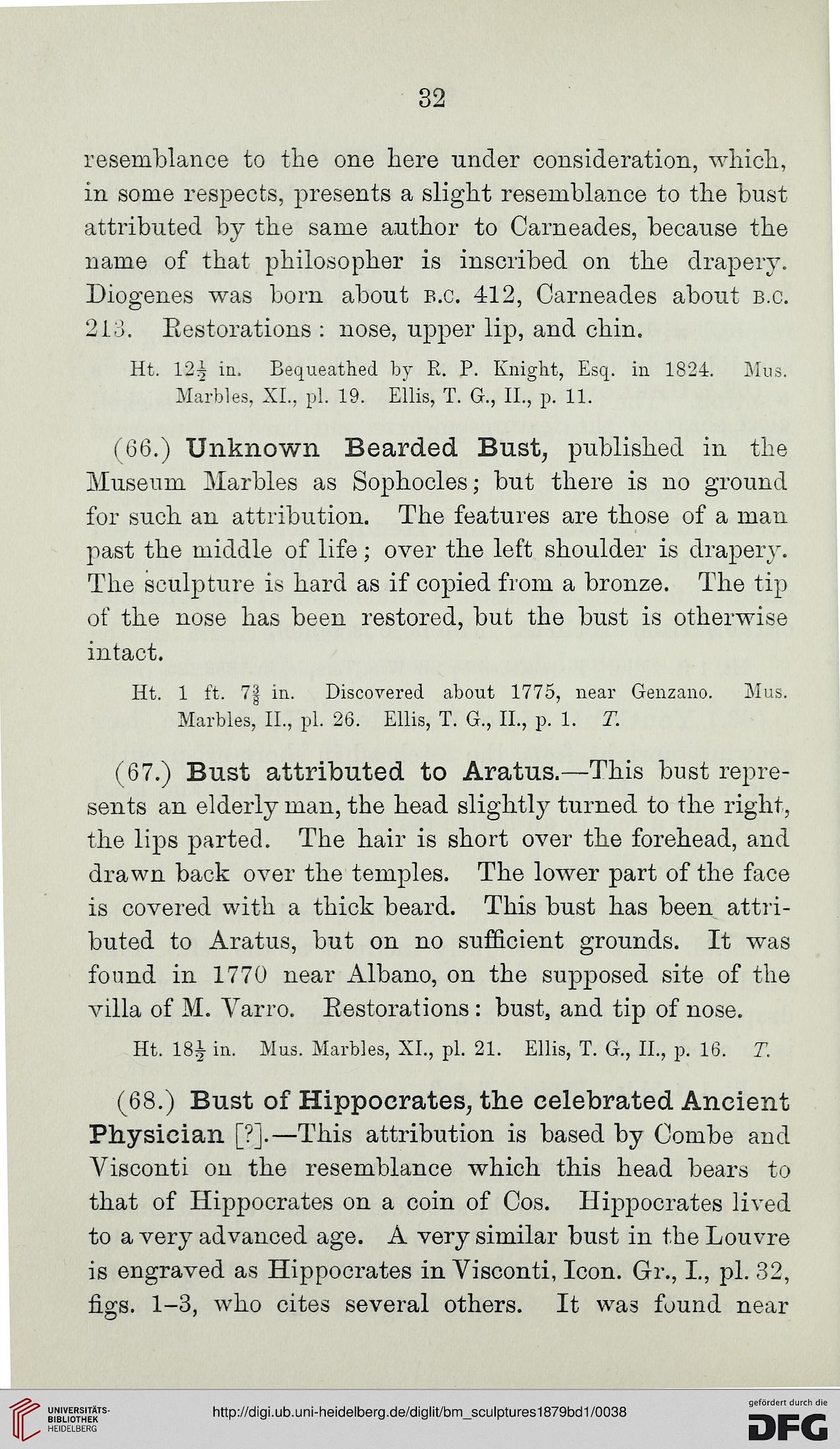32
resemblance to the one here under consideration, which,
in some respects, presents a slight resemblance to the bust
attributed by the same author to Carneades, because the
name of that philosopher is inscribed on the drapery.
Diogenes was born about B.C. 412, Carneades about B.C.
218. Restorations : nose, upper lip, and chin.
Ht, 12^ in. Bequeathed by R. P. Knight, Esq. in 1824. Mus.
Marbles, XI., pi. 19. Ellis, T. G., II., p. 11.
(66.) Unknown Bearded Bust, published in the
Museum Marbles as Sophocles; but there is no ground
for such an attribution. The features are those of a man
past the middle of life; over the left shoulder is draper}'.
The sculpture is hard as if copied from a bronze. The tip
of the nose has been restored, but the bust is otherwise
intact.
Ht. 1 ft. 7| in. Discovered about 1775, near Genzano. Mus.
Marbles, II., pi. 26. Ellis, T. G., II., p. 1. T.
(67.) Bust attributed to Aratus.—This bust repre-
sents an elderly man, the head slightly turned to the right,
the lips parted. The hair is short over the forehead, and
drawn back over the temples. The lower part of the face
is covered with a thick beard. This bust has been attri-
buted to Aratus, but on no sufficient grounds. It was
found in 1770 near Albano, on the supposed site of the
villa of M. Varro. Restorations : bust, and tip of nose.
Ht. 18± in. Mus. Marbles, XL, pi. 21. Ellis, T. G, II., p. 16. T.
(68.) Bust of Hippocrates, the celebrated Ancient
Physician [?].—This attribution is based by Combe and
Visconti on the resemblance which this head bears to
that of Hippocrates on a coin of Cos. Hippocrates lived
to a very advanced age. A very similar bust in the Louvre
is engraved as Hippocrates in Visconti, Icon. Gr., I., pi. 32,
figs. 1-3, who cites several others. It was found near
resemblance to the one here under consideration, which,
in some respects, presents a slight resemblance to the bust
attributed by the same author to Carneades, because the
name of that philosopher is inscribed on the drapery.
Diogenes was born about B.C. 412, Carneades about B.C.
218. Restorations : nose, upper lip, and chin.
Ht, 12^ in. Bequeathed by R. P. Knight, Esq. in 1824. Mus.
Marbles, XI., pi. 19. Ellis, T. G., II., p. 11.
(66.) Unknown Bearded Bust, published in the
Museum Marbles as Sophocles; but there is no ground
for such an attribution. The features are those of a man
past the middle of life; over the left shoulder is draper}'.
The sculpture is hard as if copied from a bronze. The tip
of the nose has been restored, but the bust is otherwise
intact.
Ht. 1 ft. 7| in. Discovered about 1775, near Genzano. Mus.
Marbles, II., pi. 26. Ellis, T. G., II., p. 1. T.
(67.) Bust attributed to Aratus.—This bust repre-
sents an elderly man, the head slightly turned to the right,
the lips parted. The hair is short over the forehead, and
drawn back over the temples. The lower part of the face
is covered with a thick beard. This bust has been attri-
buted to Aratus, but on no sufficient grounds. It was
found in 1770 near Albano, on the supposed site of the
villa of M. Varro. Restorations : bust, and tip of nose.
Ht. 18± in. Mus. Marbles, XL, pi. 21. Ellis, T. G, II., p. 16. T.
(68.) Bust of Hippocrates, the celebrated Ancient
Physician [?].—This attribution is based by Combe and
Visconti on the resemblance which this head bears to
that of Hippocrates on a coin of Cos. Hippocrates lived
to a very advanced age. A very similar bust in the Louvre
is engraved as Hippocrates in Visconti, Icon. Gr., I., pi. 32,
figs. 1-3, who cites several others. It was found near




